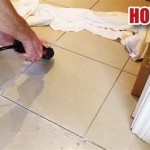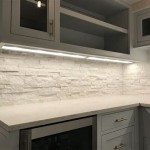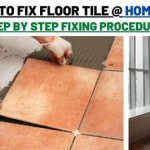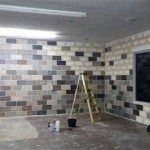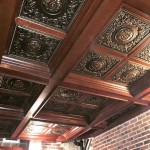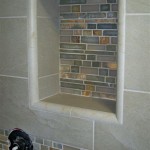Understanding the Feasibility of Tiling Over Drywall in a Shower Setting
The question of utilizing drywall as a substrate for tile in a shower environment is a common concern for homeowners and contractors alike. While seemingly straightforward, the suitability of this approach hinges on a nuanced understanding of drywall properties, moisture resistance, and proper installation techniques. Conventional drywall, often referred to as gypsum board, is primarily designed for interior wall and ceiling applications in areas with minimal moisture exposure. Its composition, consisting of a gypsum core encased in paper, renders it vulnerable to water damage, which can lead to structural degradation, mold growth, and ultimately, tile failure. Therefore, directly applying tile over standard drywall in a shower is generally not recommended due to the inherent risks associated with moisture penetration.
However, there are specific types of drywall engineered to withstand higher levels of humidity and moisture. These specialized products may be considered as potential substrates for tile in a shower, provided that stringent installation protocols and supplementary waterproofing measures are implemented. It is imperative to meticulously evaluate the characteristics of the chosen drywall product and adhere to manufacturer guidelines to mitigate the risks associated with moisture-related issues. Furthermore, local building codes and regulations should be carefully consulted to ensure compliance with stipulated requirements for shower wall construction.
Evaluating Moisture-Resistant Drywall Options
Moisture-resistant drywall, often identified by a green or purple facing paper, offers enhanced protection compared to standard drywall. These products are designed to resist water absorption to a greater degree, making them potentially suitable for use in areas with moderate moisture exposure, such as bathrooms. However, it's important to recognize that even moisture-resistant drywall is not entirely waterproof. Prolonged or excessive exposure to water can still compromise its integrity. The key distinction lies in the enhanced resistance to moisture, allowing for a greater margin of safety when compared to standard drywall. Therefore, relying solely on moisture-resistant drywall for waterproofing in a shower environment is insufficient and requires additional measures.
It's critical to understand the limitations of moisture-resistant drywall. While it can tolerate some humidity and incidental water contact, it is not designed for constant or direct water exposure. In a shower setting, water can penetrate through grout lines, around fixtures, and from splashes, potentially reaching the drywall substrate. This moisture accumulation can lead to gradual deterioration, even with moisture-resistant drywall. Selecting a high-quality, specifically designed for wet areas product is crucial. Check all product specifications and ensure it meets or exceeds local waterproofing standards.
The term "moisture-resistant" is often misinterpreted as "waterproof." This misunderstanding can lead to improper installation and ultimately, water damage. Therefore, it's essential to clarify the specifications of the chosen product and understand its intended use. Furthermore, supplementary waterproofing measures, such as the application of a liquid waterproofing membrane or the use of a waterproof backer board, are typically required to ensure adequate protection in a shower environment.
Implementing Waterproofing Measures for Drywall in Showers
Regardless of the type of drywall used, incorporating robust waterproofing measures is paramount to ensure the longevity and integrity of the shower enclosure. Several waterproofing systems are available, each offering varying degrees of protection and ease of installation. Liquid waterproofing membranes, typically applied over the drywall surface before tiling, create a seamless barrier against water penetration. These membranes are available in various formulations, including acrylic, elastomeric, and epoxy-based products. The choice of membrane should be based on compatibility with the chosen tile adhesive and grout, as well as the specific requirements of the project.
Another option is the use of waterproof backer boards, which are specifically designed for wet areas. These boards are typically made of cement, fiberglass, or coated foam and offer superior water resistance compared to drywall. Backer boards are installed directly over the studs, providing a solid and waterproof substrate for tile. While backer boards generally offer better protection against water damage, they can be more expensive than moisture-resistant drywall and may require more specialized installation techniques.
Proper surface preparation is crucial for the successful application of any waterproofing system. This typically involves cleaning the drywall surface, filling any gaps or imperfections, and applying a primer to promote adhesion. The waterproofing membrane or backer board should be installed according to the manufacturer's instructions, paying particular attention to seams and corners. Reinforcing these areas with waterproofing tape or sealant is often recommended to ensure a watertight seal. Failure to properly prepare the surface or install the waterproofing system can compromise its effectiveness and lead to water damage.
Considerations for Installation and Long-Term Performance
The installation process plays a critical role in the overall performance of tile over drywall in a shower. Proper framing, ensuring that the walls are plumb and level, is essential for creating a stable and even surface for tile installation. Inadequate framing can lead to uneven tile alignment, which can compromise the aesthetics and functionality of the shower. Additionally, proper ventilation in the bathroom is crucial for minimizing moisture buildup and preventing mold growth. Regularly using the exhaust fan during and after showers can significantly reduce humidity levels and extend the lifespan of the tile and substrate.
Selecting the appropriate tile adhesive and grout is also essential for long-term performance. The adhesive should be compatible with the chosen tile and substrate, and it should be applied according to the manufacturer's instructions. Using a high-quality, waterproof grout is crucial for preventing water penetration through the grout lines. Furthermore, sealing the grout regularly can help to maintain its waterproof properties and prevent staining. The type of tile used also affects the outcome. Porous tiles might allow more water to seep through and cause a potential for damage. Selecting dense, non-porous tiles is beneficial.
Regular maintenance is essential for preserving the integrity of the tiled shower enclosure. This includes cleaning the tile and grout regularly to remove soap scum, mildew, and other contaminants. Inspecting the grout for cracks or damage and repairing them promptly can prevent water penetration. Furthermore, checking the sealant around fixtures, such as showerheads and faucets, and replacing it as needed can help to maintain a watertight seal. Neglecting these maintenance tasks can lead to water damage, mold growth, and costly repairs. Ultimately, the choice of whether or not to tile over drywall in a shower setting requires careful consideration of all factors involved. Understanding the properties of drywall, implementing proper waterproofing measures, and adhering to best practices for installation and maintenance are essential for ensuring a durable and long-lasting shower enclosure.

Tile Over Drywall Showers A Common But Bad Practice Scott Hall Remodeling
Can You Put A Ceramic Wall Tile On Sheetrock For Basement Shower Quora

Can You Tile Over Drywall Master Building Materials Blog

6 Bad Ways To Build A Shower What Not Do Diytileguy

Finish Shower Without Drywalling Doityourself Com Community Forums
Should I Use Green Board Or Cement For Behind My Shower Tiles In The Bathroom Quora

Can You Tile Over Drywall Master Building Materials Blog

The Tile Journal Of Hamilton In Woodstock Ga

The Complete Guide To Installing Tile On Shower Or Bathtub Walls

How To Remove Tiled Shower Walls The Floor Elf
Related Posts

